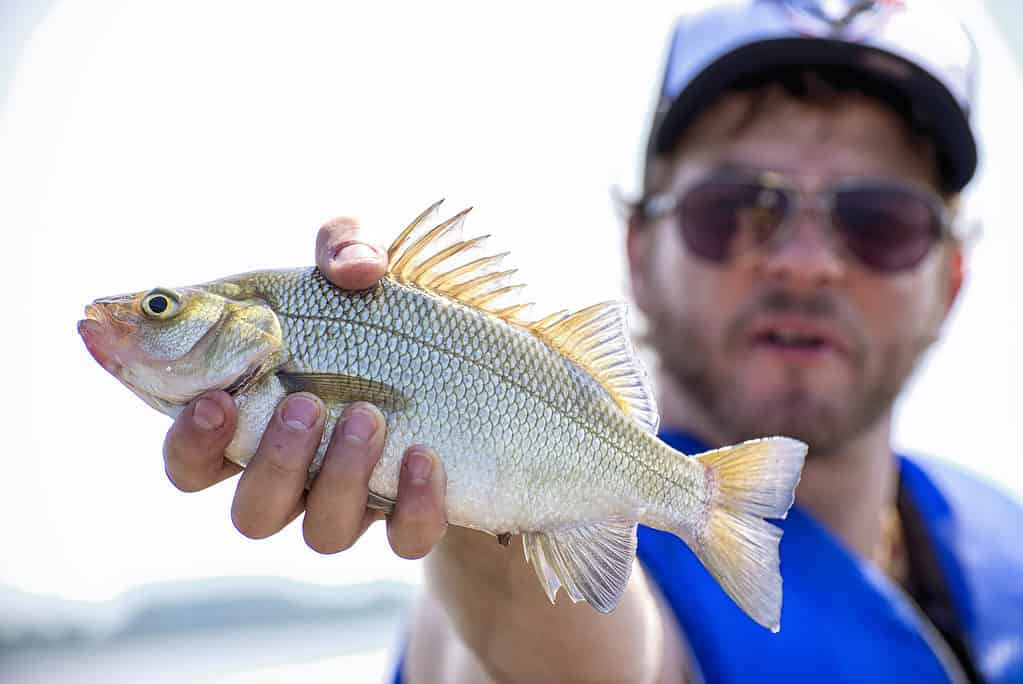Freshwater Drum
Aplodinotus grunniens
These fish are very vocal, and males make a rumbling or grunting noise during breeding season to attract a mate.
Advertisement
Freshwater Drum Facts
- Name Of Young
- Larvae
- Group Behavior
- Group
- Fun Fact
- These fish are very vocal, and males make a rumbling or grunting noise during breeding season to attract a mate.
- Estimated Population Size
- Over 100 000
- Biggest Threat
- Humans
- Other Name(s)
- Grunter, croaker, Russell fish, grinder, Graspergou, Gasper goo, grinder, and wuss fish
- Incubation Period
- 2 to 3 days
- Age Of Independence
- 5-8 days
- Average Spawn Size
- 34,000 to 66,500 eggs
- Diet
- Carnivore
- Lifestyle
- Group
- Favorite Food
- Mussels
- Common Name
- Freshwater drum
- Origin
- Central and North America
Freshwater Drum Physical Characteristics
- Color
- Grey
- Blue
- Silver
View all of the Freshwater Drum images!
The freshwater drum is native to Central and North America. It is the only species belonging to the genus Aplodinotus. These interesting fish inhabit freshwater rivers and lakes with rocky beds and sand on the bottom. They go by many names like grunter, croaker, Russell fish, grinder, Graspergou, Gasper goo, grinder, and wuss fish. In addition, they are referred to as sunfish and sheepshead fish in certain parts of the USA, United Kingdom, and Canada, but these are only nicknames.
Freshwater drums’ appearance will differ depending on their habitat. For example, they appear brown in transparent water, but in muddy water, they look silvery or grayish. These fish move in groups and are mostly active at night. They aren’t the easiest fish to catch as they show strong fighting abilities when trapped and often escape, especially from anglers. But if you are wondering if you can eat these drums, the answer is yes. They are notorious for their lack of bones and how easy they are to fillet.
Five Amazing Freshwater Drum Facts!
- The biggest recorded freshwater drum weighs around 54 pounds and measures a whopping two feet!
- They are often called grunters because males produce a grunting noise during the breeding season.
- These fish prefer inhabiting the bottoms of lakes and rivers and spend most of their lives down there looking for food.
- The current can sweep their eggs for miles, often carrying them to other lakes, rivers, and waterways until they eventually hatch.
- These fish have big teeth, similar to molars, that they use to crush clams, snails, and other mollusks.
Freshwater Drum Scientific Name
The freshwater drum’s scientific name is Aplodinotus grunniens, and they belong to the order Acanthuriformes. This order consists of 85 species in eight genera and three families of ray-finned fishes. It includes groups like Surgeonfishes, Moorish Idols, and Louvars. In addition, members of this order have sexual reproduction.
Freshwater drums’ are members of the Sciaenidae family, which is a diverse group of elongated, compressed fishes. They primarily inhabit subtropical coastal and shallow temperate waters.
Freshwater Drum Appearance
The freshwater drum fish is distinguished by its silver scales and grayish-blue overcast. They have deep, compressed bodies with a prominent lateral line that spans over the entire length of their bodies. Additionally, other identifying features include:
- A small horizontal mouth situated at the bottom of the head
- Blunt nose
- Prominent arched top
- White belly
- Spiny and elongated dorsal fin divided in two
The freshwater drum varies in size, but their average weight ranges from 1 to 8 pounds, and they can measure between 10-24 inches in length.

Freshwater drums are the only species of their family to occur in only freshwater in North America.
©Roxana Gonzalez/Shutterstock.com
Freshwater Drum Behavior
This specie of drum generally moves in large clusters. The juveniles try to gain superiority in their habitat by rivaling other species like trout-perch, emerald shiner, and yellow perch. Additionally, these fish are very vocal, and males make a rumbling or grunting noise during mating season to attract a mate. Their sounds have generated many unique nicknames like pumper, thunder, grunter, croaker, grinder, and bubbler.
Freshwater Drum Habitat
The freshwater drum is the only one in its family in North America to inhabit only freshwater. They generally spend most of their lives on the bottom of medium to large-sized rivers and lakes with depths of around 40 to 60 feet. While they are found in turbid and murky water, they prefer clear water. Anglers will venture to the Appalachian mountains, Rockies, Guatemala, and Canada to find these drums.
Freshwater Drum Diet
These mysterious fish are carnivorous and like to feed on mussels, crayfish, and insects. However, their primary source of food is organisms living in the river or lake beds. For example, insect larvae and mussels make up most of their diet. However, juveniles eating habits vary depending on the season. Therefore, in spring, during the months of April and May, they eat dipterans. But, from August to November, their diet consists of small fish. In addition, they are strong enough and have sharp teeth to prey on hard-shelled snail species.
Freshwater Drum Predators and Threats
The only animals that prey on freshwater drums are humans and other fish. In fact, during their first year of life, they serve as forage fish for several predatory fish species like the smallmouth bass and walleye. However, once they pass the first year mark, their primary predator is humans. But, for now, they are listed as Least Concern on ICUN’s Redlist.
Freshwater Drum Reproduction, Babies, and Lifespan
These bottom dwellers usually prefer open water to breed. They mate once a year, and their breeding period can last for six or seven weeks. Sexual maturity varies between the sexes of these fish. For example, female drums reach reproductive maturity at five or six years old, while males reach sexual maturity at four. Once females mature, they swim around 33 feet deep into shallow water. Their preferred water temperature is between 65 to 68 °F.
Their breeding season is usually between June and July. During this period, females will release their eggs into open water while the males swim overhead while disposing of their sperm. This behavior is known as spawning, which is common in many fish species. Females can release about 34,000 to 66,500 eggs at once, and fertilization occurs randomly. Once the eggs are fertilized, they float to the surface and only take two to three days to hatch. The larvae emerge and measure around 0.13 inches long. They will stay on the surface for a few more days until they have grown to approximately 0.17 inches. It only takes five to eight days for these fish to transform into their adult form, measuring 0.59 inches. During this stage, they become independent and swim around in search of food.
Lifespan/Longevity
Freshwater drums have a relatively long lifespan of 6 to 13 years in the wild. Unfortunately, there are no records of how long they live in captivity.
Freshwater Drum Population
There are no exact recordings of the freshwater drum’s population size, but researchers assume their numbers exceed 100 000 individuals.
Similar Fish Species
There are several fish species that resemble the freshwater drum, and they are often misidentified. Here are three similar fish species.
Sheepshead
The sheepshead is not just a nickname for the freshwater drum; it’s actually its own species. They are found in the coastal waters of the Western Atlantic, southwest Florida, and the Gulf of Mexico. In addition, smaller populations are also spread throughout Central and South America, all the way to the southern tip of Brazil. Furthermore, they can also occur in brackish waters. They are close relatives of the yellowfin bream and belong to the same family.
Sheepsheads have greenish-yellow or silvery bodies with vertical markings that are evidently prominent in juveniles. Their teeth look eerily similar to humans as they have molars in their upper and lower jaws. Additionally, their dorsal and anal fins contain spines. These fish are omnivores, and their diet consists of plant matter and several species of vertebrates and invertebrates. The sheepshead is caught in large numbers around Florida because people love their taste. The best time for fishermen to catch these fish is during the months of March and April, during their mating season. However, they are caught in the Gulf of Mexico for commercial and recreational purposes.
Carp
The common carp inhabits freshwater bodies over Asia and Europe. Carps have excellent hearing, and their massive mouth helps to consume larger prey. Their diet includes animals like
- Mollusks
- Insects
- Worms
However, they also eat plant matter and algae.
These fish are covered in large, thick scales and vary in color from bronze to silver and olive green. Unfortunately, they are preyed on by larger fish and are currently listed as a Vulnerable species because of overfishing. But, even so, they are an invasive species and can easily outcompete other fish for food and space. While many US citizens don’t like the taste of carp, many cultures around the world enjoy the taste of its mild, pinky flesh. These fish breed throughout the year and females can lay a whopping 300,000 eggs at a time.
Channel Bass
The channel bass (Sciaenops ocellatus) goes by many names, such as redfish, red drum, puppy drum, red, and spot tail bass. They are species of game fish primarily found in certain areas of the Atlantic Ocean, Florida, the Gulf of Mexico, and northern Mexico. Channel bass are closely connected to black drums. In fact, these two species can reproduce and form a robust hybrid.
Some of their most distinguishing features include dark red backs that dramatically fade into a white underbelly. Additionally, channel bass has a prominent black spot or eyespot on the base of their tails and streamlined bodies. Because of their common reddish-bronze coloring, they have inherited nicknames like the redfish, but they actually come in an array of colors like copper, silvery-gray, and deep black.
The channel bass has one of the fastest-growing fish populations in the world. They prefer habitats in shallow waters, with submerged sea grass and other vegetation. In addition, they also enjoy occupying oyster reefs and have been found several miles upriver.
Channel bass’s lifecycle is quite unique. Once the female is sexually mature, she will release her egg into the water, where the male will take them and fertilize them externally. It takes the eggs around 22 to 28 hours to hatch, which produces tiny larvae that feed on plankton. It takes these larvae about two weeks to fully mature into their adult forms; from then on, growth is rapid.
Up Next
View all 91 animals that start with FFreshwater Drum FAQs (Frequently Asked Questions)
Is drums a freshwater fish?
The freshwater drum is the only one in its family in North America to inhabit only freshwater. They generally spend most of their lives on the bottom of medium to large-sized rivers and lakes with depths of around 40 to 60 feet. While they are found in turbid and murky water, they prefer clear water. Anglers will venter to the Appalachian mountains, Rockies, Guatemala, and Canada to find these drum.
What is another name for freshwater drum fish?
They go by many names like grunter, croaker, Russell fish, grinder, Graspergou, Gasper goo, grinder, and wuss fish. In addition, they are referred to as sunfish and sheepshead fish in certain parts of the USA, United Kingdom, and Canada, but these are only nicknames.
Can you smoke freshwater drum?
Freshwater drum tastes similar to tilapia. Once filleted and cooked, it has a firm, not flaky texture. You eat freshwater drums baked, broiled, fried, grilled, and smoked.
Thank you for reading! Have some feedback for us? Contact the AZ Animals editorial team.
Sources
- Wikipedia, Available here: https://en.wikipedia.org/wiki/Freshwater_drum
- Kidadl, Available here: https://kidadl.com/facts/animals/freshwater-drum-facts
- Guidesly, Available here: https://guidesly.com/fishing/fish-species/freshwater-drum

















